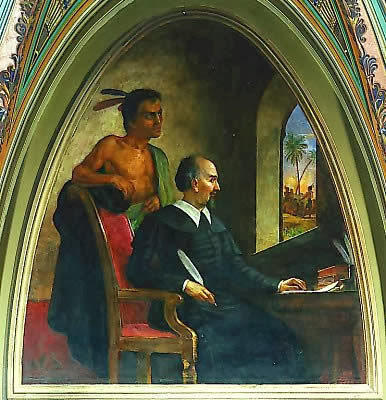Let's explore who came and what happened piece by piece. First we can take a look at New Spain.
 |
| This portrait of San Bartholome de Las Casas hangs, suprisingly, in the Senate wing of the United States Capitol Building. More on this man below. |
While on the surface, the spread of the Spanish language would seem to be a practical way of standardizing trade and commerce and making conversion to a new faith much easier, such cultural domination happened only gradually. Missionaries trained themselves to speak various languages and traders simply relied on existing trade networks and set-ups. Part of this was due to the work of one man, San Bartholome de Las Casas. Simply put, Las Casas was disgusted by what he saw as the brutal conquest that Spain was participating in against the people living with him, admittedly as his own slaves, in an exciting New World where he pledged to make a life of freedom and prosperity. His viewpoints were hard to keep to himself, and he eventually spearheaded efforts to protect the native population of Mexico from cultural annihilation. Together with the effects that Malinche had previously had on softening the heart of Hernando Cortez, this meant that Spanish colonization started to become a much more complicated affair than just mere conquest.
Missionary efforts were helped quite a lot by this mutual exploration, though sometimes they resulted in Catholicism simply being absorbed into existing religious practices. Due to this and other reasons, Spanish efforts did start to turn toward cultural dominance. Spanish did not become imposed on the populace of New Spain until 1696, but legislated cultural transformation became policy throughout the 18th century, and missionary efforts which went along with military expeditions into the northern frontiers of Alta California, Tejas, and the Rio Grande valley followed this policy, especially after the Jesuits were expelled from all Spanish dominions. While the Franciscans who followed them were not particularly fond of cultural domination, they followed the law in spreading the take-over of Spanish language and customs. Mexican independence, followed by strong native democratic participation in the new nation, eventually resulted in a reversal of imperialistic cultural and linguistic directives.
Thus the Spanish language has not completely replaced common usage of indigenous languages in Mexico even in the present day. While most if nearly all non-Spanish speakers in Mexico are functionally bilingual, the majority of pre-conquest languages have survived with enough speakers around to keep them alive. The Mexican government, in fact, recognizes 68 languages in addition to Spanish as national languages, complete with all the legal rights for those language users shared by Spanish users. This has been law since 1917.
Native culture has indeed remained dominant in some areas of southern Mexico, and Mexican culture would not be the same without them, to say nothing of how it would be without heavy infusions from the languages of those cultures into Spanish. While efforts to diversify and protect different languages have met with, let's be honest and say completely racist efforts of suppression in the United States and Canada, Mexico simply has such an inter-mixed population that such a thing would be unthinkable there. The same cannot be said for the rest of Latin America, but that is another story for a different day, and beyond the scope of this blog, at least for now.
Next post we travel 2,300 miles northward to New France and see what happened with French in the New World.

No comments:
Post a Comment